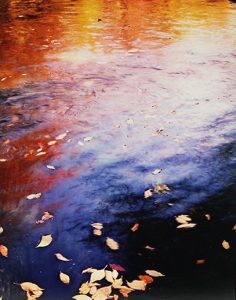
![]() Originally trained as a chemical engineer before receiving his medical degree from Harvard University, Eliot Porter turned away from his career as a biomedical researcher to practice photography. Encouraged by Alfred Stieglitz with an exhibition at An American Place in 1938, Porter honed his skills first as a bird photographer and then as an interpreter of the natural world. At a time when black and white photography was the norm for artistic work, and color was denigrated as a glitzy commercial medium, Porter honed his skills as a color practitioner, mastering the difficult dye transfer printing process. In 1962 his commitment to color photography was validated when the Sierra Club published the hugely popular book, In Wildness is the Preservation of the World, a ground-breaking publication in the history of environmental photography. Unlike his contemporary, Ansel Adams, who specialized in grand, operatic views of distant landscapes, Porter trained his eye to see pattern and meaning in the small details of nature.
Originally trained as a chemical engineer before receiving his medical degree from Harvard University, Eliot Porter turned away from his career as a biomedical researcher to practice photography. Encouraged by Alfred Stieglitz with an exhibition at An American Place in 1938, Porter honed his skills first as a bird photographer and then as an interpreter of the natural world. At a time when black and white photography was the norm for artistic work, and color was denigrated as a glitzy commercial medium, Porter honed his skills as a color practitioner, mastering the difficult dye transfer printing process. In 1962 his commitment to color photography was validated when the Sierra Club published the hugely popular book, In Wildness is the Preservation of the World, a ground-breaking publication in the history of environmental photography. Unlike his contemporary, Ansel Adams, who specialized in grand, operatic views of distant landscapes, Porter trained his eye to see pattern and meaning in the small details of nature.
Scroll down to watch and listen as Professor Kirsten Hoving, guest curator of Land and Lens, and Professor John Elder share their thoughts on Porter’s work: